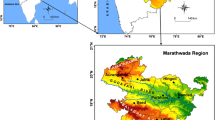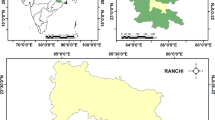Abstract
In the present study, trends of rainfall of the Central India were evaluated in monthly, seasonal, and annual time scales using the Revised Mann-Kendall (RMK) test, Sen’s slope estimator, and innovative trend method (ITM). For this purpose, the monthly rainfall data for 20 stations in Madhya Pradesh (MP) and Chhattisgarh (CG) states in Central India during 1901–2010 was used. The Sen’s slope estimator was utilized for calculating the slope of rainfall trend line. Based on the obtained results of RMK test, there is no significant trend in the stations for the January and October months. The results also showed that for MP, two out of 15 considered stations indicate significant annual trend, while the CG has four out of five stations with significant trend. The results of applying ITM test indicated that most of the stations have decreasing trends in annual (16 stations), summer (16 stations), and monsoon (11 stations) seasons, while the winter (12 stations) and post monsoon (11 stations) seasons generally show increasing trend. Unlike the RMK, the ITM shows significant increasing trend in rainfall of November and December months. The finding of current study can be used for irrigation and water resource management purpose over the Central India.







Similar content being viewed by others
References
Abdi A, Hassanzadeh Y, Talatahari S, Fakheri-Fard A, Mirabbasi R (2017) Regional drought frequency analysis using L-moments and adjusted charged system search. J Hydroinf 19(3):426–442. https://doi.org/10.2166/hydro.2016.228
Ahmadi F, Nazeri Tahroudi M, Mirabbasi R, Khalili K, Jhajharia D (2017) Spatiotemporal trend and abrupt change analysis of temperature in Iran. Meteorol Appl 25(2):314–321. https://doi.org/10.1002/met.1694
Amirataee B, Montaseri M, Sanikhani H (2016) The analysis of trend variations of reference evapotranspiration via eliminating the significance effect of all autocorrelation coefficients. Theor Appl Climatol 126(1–2):131–139
Dabanlı I, Sen Z, Yeleğen MO, Şişman E, Selek B, Güçlü YS (2016) Trend assessment by the innovative-Şen method. Water Resour Manag 30(14):5193–5203. https://doi.org/10.1007/s11269-016-1478-4
De Martino G, Fontana N, Marini G, Singh V (2013) Variability and trend in seasonal precipitation in the continental United States. J Hydrol Eng 18(6):630–640. https://doi.org/10.1061/(ASCE)HE.1943-5584.0000677
Demir V, Kisi O (2016) Comparison of Mann-Kendall and innovative trend method (Şen trend) for monthly total precipitation (Middle Black Sea Region, Turkey). 3rd International Balkans Conference on Challenges of Civil Engineering, 3-BCCCE, 19–21 May 2016, Epoka University, Tirana, Albania
Dinpashoh Y, Mirabbasi R, Jhajharia D, Abianeh HZ, Mostafaeipour A (2014) Effect of short-term and long-term persistence on identification of temporal trends. J Hydrol Eng 19(3):617–625
Gajbhiye S, Meshram C, Mirabbasi R, Sharma SK (2016) Trend analysis of rainfall time series for Sindh River basin in India. Theor Appl Climatol 125:593–608. https://doi.org/10.1007/s00704-015-1529-4
Gupta KK, Kar AK, Jena J, Jena DR (2017) Variation in rainfall trend at upstream—a threat towards filling schedule of Hirakud Reservoir, India. Int J Water 11(4):395–407. https://doi.org/10.1504/IJW.2017.088048
Hamed KH (2008) Trend detection in hydrologic data: the Mann-Kendall trend test under the scaling hypothesis. J Hydrol 349:350–363
Hamed KH, Rao AR (1998) A modified Mann-Kendall trend test for autocorrelated data. J Hydrol 204(1):182–196
Jhajharia D, Dinpashoh Y, Kahya E, Choudhary RR, Singh VP (2014) Trends in temperature over Godavari River basin in Southern Peninsular India. Int J Climatol 34(5):1369–1384
Kendall MG (1975) Rank correlation measures. Charles Griffin, London
Khalili K, Nazeri Tahoudi M, Mirabbasi R, Ahmadi F (2016) Investigation of spatial and temporal variability of precipitation in Iran over the last half century. Stoch Env Res Risk A 30(4):1205–1221
Kisi O (2015) An innovative method for trend analysis of monthly pan evaporations. J Hydrol 527:1123–1129
Koutsoyiannis D (2003) Climatic change, the Hurst phenomenon, and hydrological statistics. Hydrol Sci J 48(1):3–24
Koutsoyiannis D, Montanari A (2007) Spatial analysis of hydroclimatic tme series: uncertainty and insights. Water Resour Res 43(5):W05429 1-9
Kumar S, Merwade V, Kam J, Thurner K (2009) Streamflow trends in Indiana: effects of long term persistence, precipitation and subsurface drains. J Hydrol 374(1):171–183
Mann HB (1945) Nonparametric test against trend. Econometrica 13:245–259
Mirabbasi R, Eslamian S (2010) Delineation of groundwater quality concerning applicability of pressure irrigation system in Sirjan watershed, Iran. International Conference on Management of Soil and Groundwater Salinization in Arid Regions, 11–14 January 2010, Sultan Qaboos University, Muscat, Oman
Mirabbasi R, Kisi O, Sanikhani H, Gajbhiye Meshram S (2018) Monthly long-term rainfall estimation in Central India using M5Tree, MARS, LSSVR, ANN and GEP models. Neural Comput Applic. https://doi.org/10.1007/s00521-018-3519-9
Nazeri Tahroudi M, Khalili K, Ahmadi F, Mirabbasi R, Jhajharia D (2018) Development and application of a new index for analyzing temperature concentration for Iran’s climate. Int J Environ Sci Technol. https://doi.org/10.1007/s13762-018-1739-2
Öztopal A, Sen Z (2017) Innovative trend methodology applications to precipitation records in Turkey. Water Resour Manag 31(3):727–737. https://doi.org/10.1007/s11269-016-1343-5
Pal I, Al-Tabbaa A (2009) Trends in seasonal precipitation extremes: an indicator of climate change in Kerala, India. J Hydrol 367(1–2):62–69
Sen PK (1968) Estimates of the regression coefficient based on Kendall’s tau. J Am Stat Assoc 63(324):1379–1389
Şen Z (2011) Innovative trend analysis methodology. J Hydrol Eng 17(9):1042–1046
Şen Z (2013) Trend identification simulation and application. J Hydrol Eng 19(3):635–642
Şen Z (2017a) Hydrological trend analysis with innovative and over-whitening procedures. Hydrol Sci J 62(2):294–305. https://doi.org/10.1080/02626667.2016.1222533
Şen Z (2017b) Innovative trend significance test and applications. Theor Appl Climatol 127:939–947. https://doi.org/10.1007/s00704-015-1681-x
Tabari H, Willems P (2015) Investigation of streamflow variation using an innovative trend analysis approach in Northwest Iran. The 36th IAHR World Congress, 28 June–3 July, 2015, The Hague, the Netherlands
Theil H (1950) A rank-invariant method of linear and polynomial analysis. Part 3. Nederlandse Akademie van Wettenschappen, Proceedings 53:1397–1412
Tosunoglu F, Kisi O (2017) Trend analysis of maximum hydrologic drought variables using Mann–Kendall and Şen’s innovative trend method. River Res Appl 33(4):597–610. https://doi.org/10.1002/rra.3106
Wu H, Qian H (2017) Innovative trend analysis of annual and seasonal rainfall and extreme values in Shaanxi, China, since the 1950s. Int J Climatol 37(5):2582–2592. https://doi.org/10.1002/joc.4866
Yan T, Shen Z, Bai J (2017) Spatial and temporal changes in temperature, precipitation, and streamflow in the Miyun Reservoir Basin of China. Water 9(2):78. https://doi.org/10.3390/w9020078
Yue S, Wang C (2004) The Mann-Kendall test modified by effective sample size to detect trend in serially correlated hydrological series. Water Resour Manag 18:201–218
Zamani R, Mirabbasi R, Abdollahi S, Jhajharia D (2017) Streamflow trend analysis by considering autocorrelation structure, long-term persistence and Hurst coefficient in a semi-arid region of Iran. Theor Appl Climatol 129(1–2):33–45. https://doi.org/10.1007/s00704-016-1747-4
Zamani R, Mirabbasi R, Nazeri M, Gajbhiye Meshram S, Ahmadi F (2018) Spatio-temporal analysis of daily, seasonal and annual precipitation concentration in Jharkhand state, India. Stoch Env Res Risk A 43(4):1085–1097. https://doi.org/10.1007/s00477-017-1447-3
Acknowledgements
The authors indicate their gratitude and appreciation for the provider of the climatological data: India Meteorological Department (IMD). The authors also thank the reviewers and the Editor-in-Chief for their constructive criticisms that have improved the final version of this paper.
Author information
Authors and Affiliations
Corresponding author
Rights and permissions
About this article
Cite this article
Sanikhani, H., Kisi, O., Mirabbasi, R. et al. Trend analysis of rainfall pattern over the Central India during 1901–2010. Arab J Geosci 11, 437 (2018). https://doi.org/10.1007/s12517-018-3800-3
Received:
Accepted:
Published:
DOI: https://doi.org/10.1007/s12517-018-3800-3




